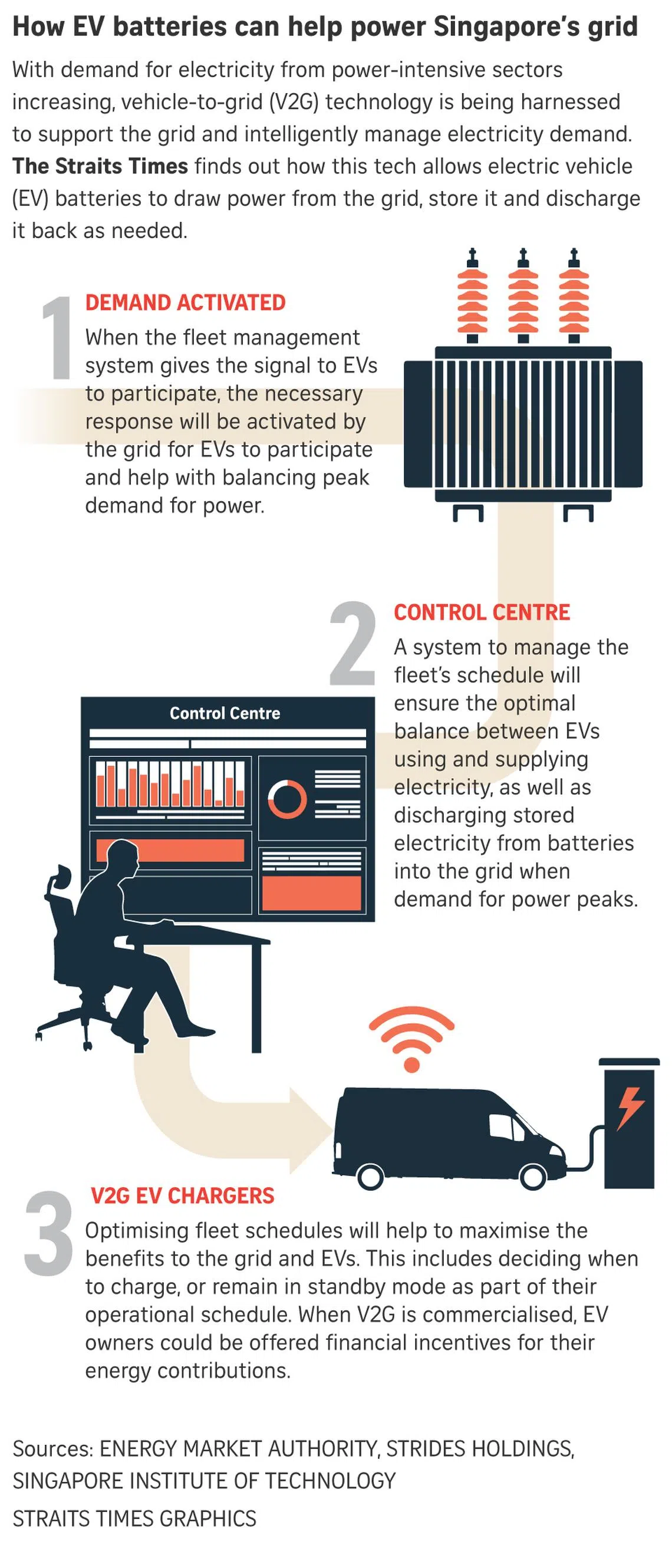Power from EV batteries could help S’pore’s grid meet peak demand, pilot to start in November
Sign up now: Get ST's newsletters delivered to your inbox

The Vehicle-to-Grid programme was made possible through a grant to a consortium led by transport operator Strides.
ST PHOTO: GAVIN FOO
Follow topic:
SINGAPORE – Power from batteries in electric vehicles (EVs) could potentially be used to help the country’s electricity grid meet peak demand, under a pilot programme that will start in November.
The vehicle-to-grid (V2G) programme, as it is called, was made possible through a grant awarded by the Energy Market Authority (EMA) and Singapore Institute of Technology (SIT) to a consortium led by transport operator Strides.
The initiative, which will involve 15 commercial vans and 10 V2G-enabled EV chargers, will be tried out in Punggol and run for three years.
It was announced during the Singapore International Energy Week, held at Marina Bay Sands, on Wednesday morning. The event will run until Friday.
The V2G pilot comes as EMA estimates that system peak demand in Singapore is expected to grow by up to 6.5 per cent annually from 2023 to 2028, driven by increasing demand from electricity-intensive sectors such as the digital economy, advanced manufacturing, high-tech farming and vehicle electrification.
This technology can be bidirectional, meaning that the batteries in the EVs can draw power from the grid, store it and then discharge it back to the grid when needed.
“The V2G technology transforms EVs from mere transport vehicles into mobile energy-storage units,” said SIT Assistant Professor Dhivya Sampath Kumar. “When fully charged, an EV’s battery often holds more power than is necessary for its immediate travel needs. This excess energy is invaluable, especially during times when the electricity grid experiences high demand. With advanced charging infrastructure in place, EVs have the capability to both draw power for charging and return excess power to the grid.”
Announcing the V2G initiative on Wednesday, EMA chairman Richard Lim said: “Singapore targets to have all vehicles run on cleaner energy by 2040, and some of these could participate in vehicle-to-grid solutions. V2G is nascent today, with just a few commercial models of EVs capable of supporting bidirectional charging. However, it may become more developed as more EVs are adopted.”
He added that it was timely to kick-start our efforts to explore the emerging technology.
Mr Low Xin Wei, EMA assistant chief executive of Markets and Systems Division, said: “The V2G testbed will allow EMA to assess its viability and, if viable, unlock the potential to implement V2G on a broader scale to support Singapore’s energy transition.
“The testbed will also allow us to assess if there is a business case for V2G for fleets, considering their operational needs and the costs of V2G.”
Prof Dhivya said that when the V2G technology is commercialised, EV users who participate in V2G programmes would have the opportunity to earn money by selling excess energy stored in their vehicle’s battery back to the grid during peak demand periods. Their compensation may come in the form of payments, credits on energy bills, or reduced charging costs.
Strides president Tan Kian Heong said that apart from validating the economic benefits and operational needs for large-scale V2G implementation from a commercial and regulator’s point of view, the pilot programme also aims to study the impact of V2G charging on EV batteries.

Strides, SMRT’s business arm that also operates a fleet of taxis under Strides Premier, will also develop a fleet management system to track the status of EVs and optimise fleet schedules to enable the EVs to provide grid services – including when to charge and when to remain in a standby mode as part of the operational schedule.
Mr Tan noted that the fleet management platform must also monitor the health of EV batteries to make sure the frequent charge and discharge cycles associated with V2G do not have a negative impact on the battery’s lifespan.
He added that V2G tech enables EVs to export their unused battery capacity back into the grid to fill gaps in renewable energy generation that can be intermittent, and “support Singapore’s aim of achieving net-zero emissions by 2050 as part of the Long-Term Low-Emissions Development Strategy”.
Additional reporting by Shabana Begum

